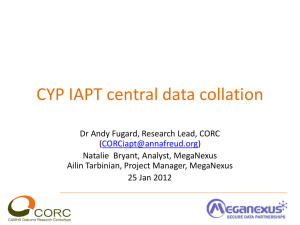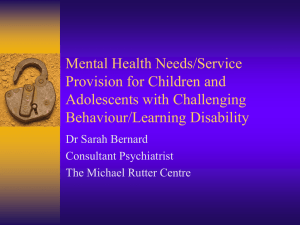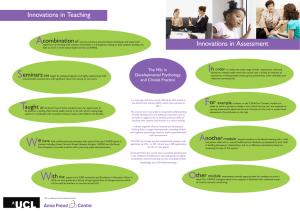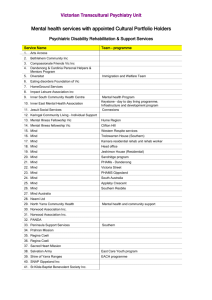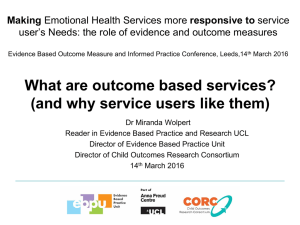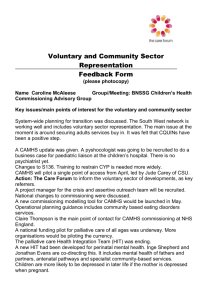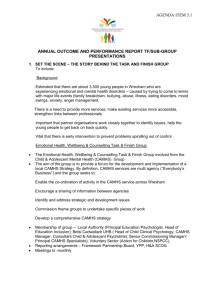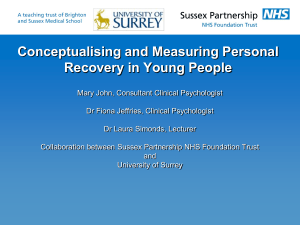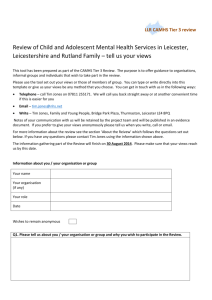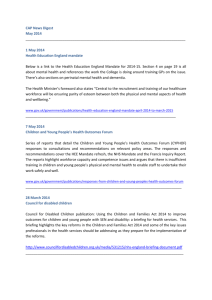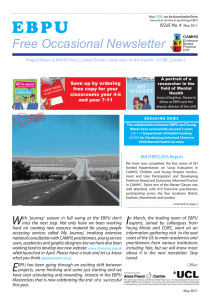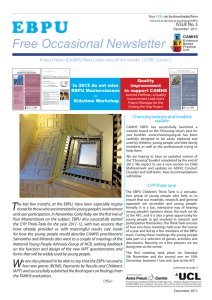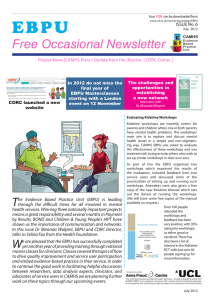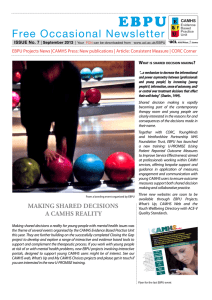Free publications From camHs press
advertisement
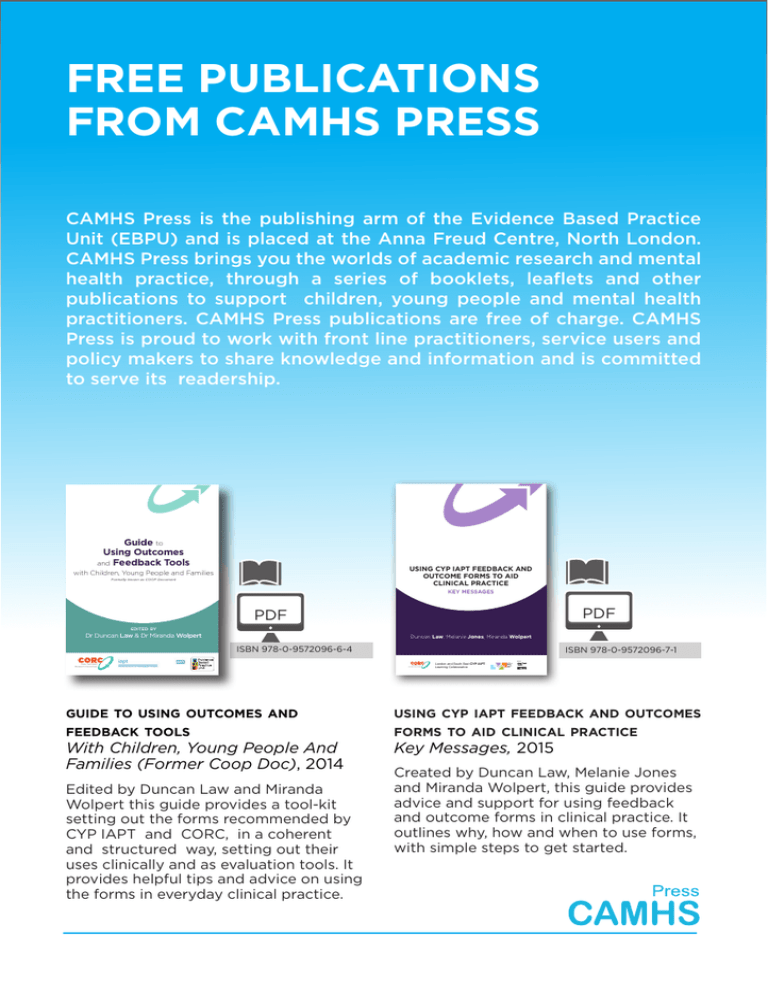
Free publications from CAMHS Press CAMHS Press is the publishing arm of the Evidence Based Practice Unit (EBPU) and is placed at the Anna Freud Centre, North London. CAMHS Press brings you the worlds of academic research and mental health practice, through a series of booklets, leaflets and other publications to support children, young people and mental health practitioners. CAMHS Press publications are free of charge. CAMHS Press is proud to work with front line practitioners, service users and policy makers to share knowledge and information and is committed to serve its readership. Guide to Using Outcomes Feedback Tools and Using CYP iAPT feedbACk And oUTCome forms To Aid CliniCAl PrACTiCe with Children, Young People and Families Formally known as COOP Document keY messAges PDF PDF edited by Dr Duncan Law & Dr Miranda Wolpert Duncan law, Melanie Jones, Miranda Wolpert ISBN 978-0-9572096-6-4 Child Outcomes Research Consortium ISBN 978-0-9572096-7-1 Child Outcomes Research Consortium London and South East CYP IAPT Learning Collaborative Part of guide to using outcomes and using cyp iapt feedback and outcomes feedback tools forms to aid clinical practice With Children, Young People And Families (Former Coop Doc), 2014 Edited by Duncan Law and Miranda Wolpert this guide provides a tool-kit setting out the forms recommended by CYP IAPT and CORC, in a coherent and structured way, setting out their uses clinically and as evaluation tools. It provides helpful tips and advice on using the forms in everyday clinical practice. Key Messages, 2015 Created by Duncan Law, Melanie Jones and Miranda Wolpert, this guide provides advice and support for using feedback and outcome forms in clinical practice. It outlines why, how and when to use forms, with simple steps to get started. THRIVE The AFC–Tavistock Model for CAMHS Miranda Wolpert,Rita Harris, Melanie Jones, Sally Hodges, Peter Fuggle, Rachel James, Andy Wiener,Caroline McKenna, Duncan Law, Peter Fonagy PDF Coping Thriving Getting Risk Support PDF Getting Help ISBN 978-0-9572096-8-8 ISBN 978-0-9572096-0-2 Getting More Help thrive The AFC-Tavistock model for CAMHS, 2014 A collaboration of authors from the AFC and The Tavistock and Portman NHSFT present THRIVE: a new conceptual model for CAMHS. The THRIVE model offers a radical shift in the way that services are conceptualised and potentially delivered to inform national debate on the future of CAMHS. goals and goal based outcomes (gbo’s) Some useful information, 2013 The booklet was written by Dr Duncan Law, a member of the CORC Committee and Board, and offers information and advice on using Goals and Goal Based Outcomes. PDF PDF ISBN 978-0-9572096-4-0 ISBN 978-0-9572096-2-6 current view tool ebpu log book This booklet was developed by members of CAMHS EBPU as part of the Payment by Results in CAMHS Pilot Project. It gives an overview of the Current View Tool and provides guidance on completing the tool. A booklet developed by CAMHS EBPU to help front line practitioners learn from their experience. Use the PDSA forms when you want to try something new to improve your practice. Every time you finish a PDSA cycle you start a new one trying to improve what you’ve done in the previous cycle and it becomes a learning process. Completion Guide, 2013 Learning from Experience, 2013 PDF PDF ISBN 978-0-9553956-7-3 ISBN 978-0-9553956-8-0 i gotta feeling Top tips for feeling good (aimed at primary school children), 2011 This booklet has been designed by Help4Pupils to help children when they are feeling sad, worried or troubled. It is full of fun simple tips on what to do to improve their mood and maintain emotional wellbeing. how to get up and go when you’re feeling low Top tips for feeling good (aimed at secondary school pupils), 2011 This booklet has been designed by Help4Pupils to help children when they are feeling sad, worried or troubled. It is full of fun simple tips on what to do to improve their mood and maintain emotional wellbeing. NOT JUST A NUMBER! Forms may use numbers for each question and your counsellor can add these to the information you have shared discussions to get the best picture of TANDING inyour specific needs. UNDERSD YOUR YOU AN TIES: DIFFICUL D AN S HOW FORM AIRES CAN HELP NN QUESTIO IN SITUATIONS WHEN: there isn’t time to say everything you might want to you feel embarrassed or scared to say things out loud to a therapist or counsellor the issue might not seem so important - but actually is you feel too ‘under the spotlight’ in counselling, particularly early on IF YOU NEED EXTRA HELP WITH QUESTIONNAIRES AND FORMS: your therapist or counsellor will be able to help by reading questions aloud and explaining them, but the bottom line is that the questionnaire or form should be helpful and you should feel comfortable completing it. OR IF YOU WANT TO: PDF say things in a different way remember things that you want to say write things that might be more difficult to say aloud. Having a shared understanding with your therapist is important, which is why forms might be used at different times including: after each session ISBN 978-0-9553956-2-8 It is OK not to fill in a questionnaire or form – you should never feel pressured to complete something that you don’t understand or want to do – this is about you after all! the first time you go for counselling or therapy before you leave counselling or therapy. PDF Scale Mental Well-being Edinburgh Warwick– ) The (WEMWBS about Below are some tick the thoughts. each of and feelings experience your statements describes best that box (EDE -Q over the last 2 weeks 6.0) ALL OF SOME TIME OF THE TIME OFTEN 5 4 THE to Please 5 aire RARELY Session No OF 3 refer NONE h 4 ' TIME tionn only. 5 2 only THE 3 Time: Date: EVERY ons 4 1 ques days) DAY 5 2 (28 on 3 around the word that shows how often each of these things happen to you. questi Please put a circle 23-27 4 STATEMENTSthe 1 future DAYS the 6 no right or wrong answers. 5 There2 are inati weeks you. 3 thatabout 16-22 4 four 1 optimistic 5 DAYS ber exam past Thank 2 5 feeling 3 ons.been 4 13-15 1 6 I’ve the 5 Remem useful 2 DAYS 4 feeling 3 with questi been 4 1 right. I’ve 5 2 people relaxed 6-12 the 5 DAYS 3 the feeling in other r all 6 3 been on 4 1-5 I’ve interested 41 5 er 2 0 1 2 3 feelingDAYS 2 3 been 5 4 numb 1 I’ve NO to spare 5 3 well 2 DAYS Never Sometimes Often Always energy 1 I feel sad or empty36 1 problems had priate 4 questi lly. 1 4 I’ve with 5 2 2 ing dealing appro 5 carefu Never Sometimes Often Always been 0 2 1 Nothing is much fun3anymore 4 ... 3 I’ve clearly the 6 follow on 5 2 t of 1 myself 3 4 DAYS er been thinking about circle only. : The questi 4 28 Never Sometimes Often Always 3 1 I have trouble sleeping 2 good 5 amoun I’ve 5 2 people 0 feeling 6 3 ctions each the t (wheth PAST Please days) 3 1 or to other been 4 I’ve close 1 12: (28 5 THE Never Sometimes Often Always limit 4 I have problems 4 2 with my appetite Instru read hours ce feeling to or weigh OF 5 3 1 to weeks been mind 2 1 I’ve 64 Please confident own 0 2 influen ions four 3 no energy MANY trying waking feeling Never Sometimes Often Always 5 I have up my shape to 4 for things3 (8 been 1 1 to make I’ve HOW 5 Questpast rately your t able 2 timein order 2 ON ce been the Never Sometimes Often Always 6 I am tired a lot I’ve 6 foods s of all delibe ded)? 1 3 weigh things loved0 4 at any orabout influen feeling things 1 been to succee periodng 5 dietshape I’ve beeneating in new Never Sometimes Often Always 7 I2cannot think clearly you eat 3 6 long anythi have your shape interested youryour 0 for been Have youyou ingI’ve your 1 4 t? ce cheerful Never Sometimes Often Always 8 I feel worthless ce foodnot ded)? 2 5 e from gone t eating 6 feeling ch regard 1 or weigh been you influen 0 I’ve 3 stoma succee rules to influended)? exclud to withouor Never Sometimes Often Always 9 1 I feel like I don’t want to move 4 to e 5 Have t? 6 have succee empty more) shape triedin order 2 2006 definitin order you an weigh 2 your 0 10 I feel restless 3 have flat 4 you like not Never Sometimes Often Always of Edinburgh, 5 6 have or follow limit) you University 1 very to and to Have you er or it (for not shape a totally 2 or in of3Warwick that 4 tried a calorie 5 er g)? 3 (wheth University 0 e desireyour have s madeted you le, Scotland, 2 1 to cing readin 3 Health 4 Have examp (wheth a definit © NHS (for calorie interes , or desire in (for or are 0 had of influen e 1 4 or weight 2 you sation it very ted g)? 3 you aim ? eating readin a definit Beglin interes things 0 Have the , or a conver t made 1 had 2 food,on eating are Sarah ing 5 with you WEMWBS and you sation weigh t? trate l over ch? 0 or g about follow 1 Have SUM: g, weigh things Fairburn contro a conver G shapeon 6 stoma thinkinto concen gain ing her lt workin 0 losing Has trate le, of g about follow might NHS ID: difficu Christop 7 examp concen g, you e fear 2008 © thinkin lt to workin that Service allocated Has le, a definit e fear difficu case ID t? had 8 examp weigh you a definit lose Have had to 1/1—Depression/ Low Mood — C h i l d / Y o u n g P e r s o n Version 7 Questions © 2003 Bruce F. Chorpita, Ph.D 9 you Visual Solution © Slavi Savic, EBPU fat? desire Have felt PAGE 10 you a strong NEXT Have had THE 11 TO you E GO Have 12 PLEAS / How are things? / 20 rder g Diso rned Eatin ons are conce answe Please London and SouthEast CYP-IAPT www.cypiapt.org www.corc.uk.net 1/3 PAGE 6.0 EDE-Q choosing what’s best for you What scientists have found helps children and young people who are sad, worried or troubled, 2007 A booklet that explains the latest research in this area to children and families to help them make treatment choices. More than 25,000 copies have so far been distributed across the UK and beyond. The booklet has been translated into Swedish. understanding, and helping you and your problems – how forms and questionnaires can help 2014 This short leaflet explains a young person’s journey through CAMHS. All CAMHS Press produced material is free of charge. Requests for a copy of our booklet can be sent to our email: EBPU@annafreud.org. A copy of our booklet can be downloaded as a PDF file from EBPU website: www.ucl.ac.uk/ebpu or CORC website: www.corc.uk.net PDF evidence based practice unit: Everything you need to know, 2015 This brochure introduces the reader to the unit’s range of activities and objectives through short summaries and engaging visuals. Readers are offered an accessible overview of EBPU and directed to further sources of information. websites that might be of interest corc website www.corc.net This grassroots learning collaboration offer free training to the members, consultancy to interested parties and advise government. youth wellbeing directory www.youthwellbeingdirectory.co.uk The overarching aims of this directory and quality assessment tool are to guide and facilitate funders’ decisionmaking and to provide templates to enable providers to self-report good service provision and innovation across a range of contexts (statutory services, non-statutory voluntary sector organisations and private companies). .org www.mycamhschoices My CAMHS Choices is a website featuring real life experiences of mental health services for young people and families, by young people and professionals. my camhs choices http://mycamhschoices.org This website features video interviews with real clinicians and young people. You might like to look at this with a friend, trusted adult, or your CAMHS worker. This website has been created by young people with experience of Child and Adolescent Mental Health Services (CAMHS). CAMHS Press, 21 Maresfield Gardens, London NW3 5SD choosing website www.choosing.org.uk This site aims to help you make the best choices for you. Knowing “the facts” makes it easier to make choices, but working out what “the facts” are is not always easy.
